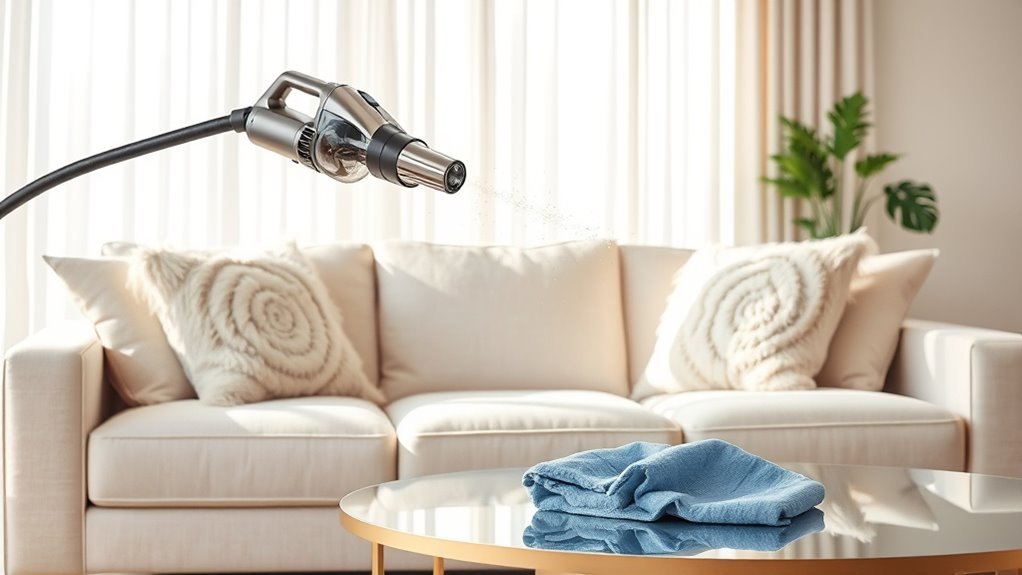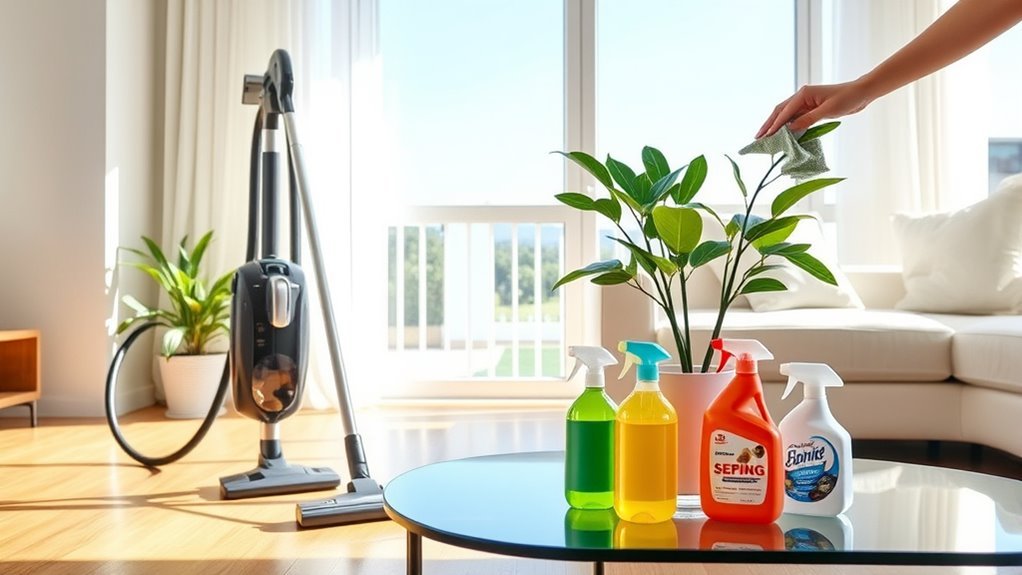How to Clean Your Allergens in 10 Minutes
To clean allergens in 10 minutes, start by quickly dusting high-allergen spots like blinds and baseboards using a microfiber cloth to trap dust effectively. Next, vacuum key areas like rugs and furniture using a vacuum with a HEPA filter for best results. Finally, open a window or turn on an air purifier to refresh the air fast. If you keep applying these smart steps, you’ll notice lasting relief and cleaner air—and there’s plenty more to help you manage allergens efficiently.
Identify Common Household Allergens

There are five common household allergens you should watch out for: dust mites, pet dander, mold, pollen, and cockroach droppings. These common indoor allergens are often hidden in your bedding, furniture, and even air vents, silently acting as allergy symptom triggers. To reclaim your freedom from sneezing fits and itchy eyes, start by pinpointing where these allergens gather. For instance, dust mites thrive in warm, humid places like mattresses, while pet dander clings to fabrics. Mold loves damp corners, and pollen sneaks in through open windows. Cockroach droppings often hide in dark, neglected spots. Once you know these trouble spots, you can better target your cleaning efforts and reduce your exposure to these pesky allergy symptom triggers.
Quick Dusting Techniques to Reduce Allergens
You’ll want to pick the right dusting tools, like microfiber cloths or electrostatic dusters, to trap allergens effectively. Focus on high-allergen areas such as blinds, baseboards, and ceiling fans where dust tends to settle. Quick, regular dusting in these spots can make a big difference in reducing allergens around your home.
Effective Dusting Tools
Choosing the right dusting tools can make a big difference in how effectively you reduce allergens in your home. Microfiber cloths are your best friend—they trap dust instead of just moving it around, giving you a cleaner, fresher space in no time. Pair them with a gentle dusting spray designed to capture particles, and you’ll see even better results. These sprays help loosen stubborn dust without leaving residue, so you’re not just pushing allergens from one spot to another. Keep a set handy in each room for quick touch-ups whenever you need. With the right tools, you’re not stuck spending hours cleaning—you’re free to enjoy a healthier home with minimal effort. Dusting becomes less of a chore and more of a quick win for your well-being.
Target High-Allergen Areas
Many surfaces in your home collect more allergens than you might expect, making them key spots for quick dusting. Start by focusing on high traffic areas like entryways, living rooms, and hallways, where dust and pollen tend to accumulate fast. Don’t forget pet zones—your furry friend’s favorite spots gather dander and fur, so give couches, beds, and pet beds a swift wipe down. Use a microfiber cloth or an electrostatic duster to trap particles effectively without spreading them around. By targeting these high-allergen areas regularly, you’ll reduce irritants in your space quickly and easily. This simple strategy helps you breathe easier and enjoy your home with more freedom, all in just a few minutes.
Efficient Vacuuming Strategies

Vacuuming at least twice a week can drastically reduce allergens in your home. To maximize allergy prevention, use vacuuming techniques that focus on slow, deliberate strokes, allowing the vacuum to pick up dust, pet dander, and pollen effectively. Don’t rush; cover each area thoroughly, especially carpets and rugs where allergens settle deeply. Make sure to use a vacuum with a HEPA filter to trap fine particles instead of releasing them back into the air. Also, vacuum your upholstered furniture and curtains regularly since allergens can hide there too. By adopting these efficient vacuuming strategies, you’re not just cleaning—you’re reclaiming your space and breathing easier, giving yourself the freedom to enjoy a healthier, allergen-reduced home.
Fast and Effective Air Purification Tips
Although thorough cleaning is essential, quickly improving your indoor air quality can make a big difference in reducing allergens. You don’t need hours to boost your space—simple air purification methods can work wonders fast. Start by opening windows to let fresh air circulate, flushing out dust and pollen. Using a portable air purifier with a HEPA filter traps airborne allergens effectively, giving you cleaner air within minutes. You might also try placing houseplants known for air-purifying traits, like spider plants or peace lilies, to naturally improve air quality. Keep fans running to help circulate purified air and prevent stagnation. These fast, effective steps let you breathe easier and reclaim your freedom from allergens without lengthy routines.
Rapid Cleaning of Soft Furnishings

If you want to reduce allergens quickly, focusing on your soft furnishings is a smart move. You’ll want to target furniture fabrics that trap dust, pet dander, and pollen. Use appropriate cleaning solutions that are safe for the material to avoid damage while eliminating allergens fast. A swift vacuum with a brush attachment can lift most irritants, followed by spot cleaning with a gentle solution.
| Furniture Fabrics | Recommended Cleaning Solutions | Quick Tips |
|---|---|---|
| Upholstery | Mild detergent, vinegar mix | Test solution first |
| Cushions | Baking soda, fabric spray | Air out after clean |
| Curtains | Vacuum, steam cleaner | Remove and wash if possible |
Simple Maintenance Habits for Long-Term Allergen Control
While quick cleanups tackle immediate allergen buildup, maintaining a consistent routine is key to keeping irritants at bay over time. You can’t rely on occasional deep cleans alone; sticking to a routine cleaning checklist helps you stay ahead of allergens daily. Incorporate allergen prevention tips like wiping down surfaces regularly, vacuuming with a HEPA filter, and washing bedding weekly. Don’t forget to keep humidity low and air filters clean to reduce dust mites and mold. These simple maintenance habits free you from constant sneezing and discomfort, letting you enjoy your space without worry. By making these tasks part of your routine, you’ll control allergens efficiently and reclaim your freedom to live comfortably.
Frequently Asked Questions
Can Cleaning Allergens in 10 Minutes Prevent Allergy Symptoms Entirely?
Imagine breathing freely without a single sneeze—does quick cleaning guarantee that? While a 10-minute allergen cleanup helps with allergy prevention by reducing triggers, it won’t entirely stop symptoms. You won’t find total freedom from allergies with just a swift routine, but quick cleaning is a powerful step toward reclaiming your space. Combine it with other habits, and you’ll feel closer to the fresh, unrestricted life you deserve.
Are Natural Cleaning Products Effective Against Household Allergens?
You’ll find eco friendly solutions can be quite effective for allergen removal around your home. Natural cleaning products often contain ingredients that tackle dust, pet dander, and mold without harsh chemicals, giving you a safer way to breathe easier. While they might take a bit more effort than conventional cleaners, they’re great if you want freedom from toxins and a healthier environment. Just make sure to choose ones proven to target your specific allergens.
How Often Should I Deep Clean to Keep Allergens at Bay?
Think of your home as a garden that needs regular watering to stay vibrant. To keep allergens from taking root, you’ll want to stick to a weekly schedule for your cleaning frequency. Deep cleaning once a week helps you breathe easier and feel free, without being chained to endless chores. It’s about finding that sweet spot where your space stays fresh, and you still have time to enjoy life outside.
Can Pets Increase Allergen Levels Despite Quick Cleaning?
Yes, pets can definitely increase allergen levels even if you clean quickly. Pet dander is a common allergen that sticks to surfaces and floats in the air, making allergen control more challenging. You’ll want to clean regularly and use HEPA filters to keep dander down. While quick cleaning helps, managing pet-related allergens requires consistent effort to truly enjoy your space freely without sneezing or discomfort.
Is It Necessary to Wear a Mask While Cleaning Allergens?
They say “an ounce of prevention is worth a pound of cure,” and when it comes to mask effectiveness during cleaning, that’s spot on. Wearing a mask can shield you from inhaling dust and allergens, especially if your cleaning techniques kick up particles. If you want the freedom to breathe easy while tidying up, slipping on a mask isn’t a hassle—it’s a smart move to protect your lungs without slowing you down.






